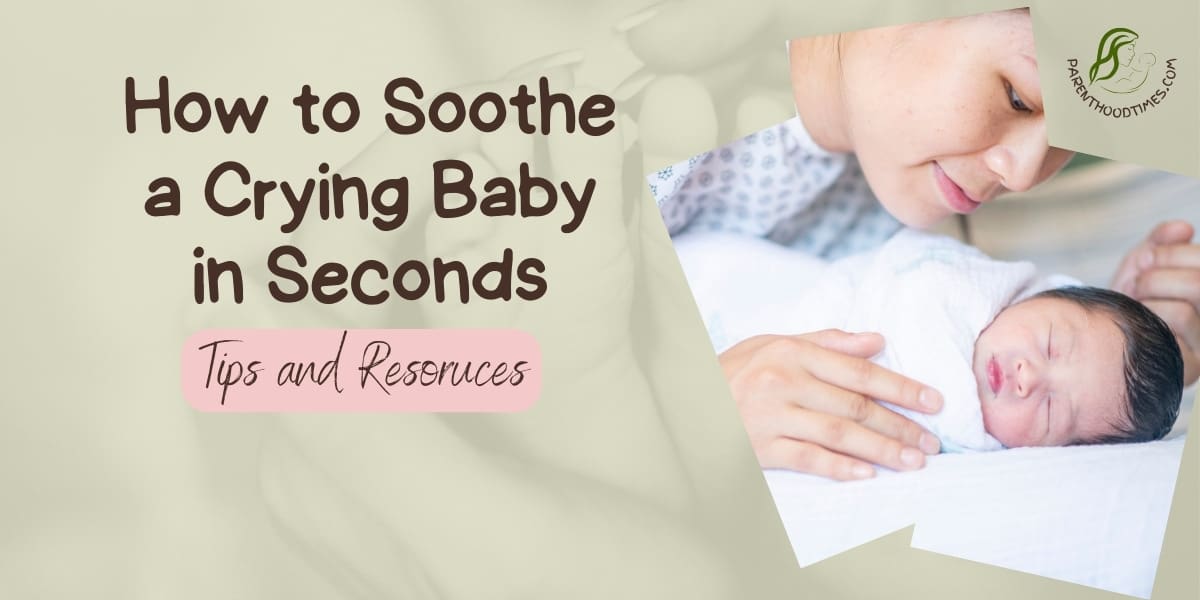How to Soothe a Crying Baby in Seconds: Practical Tips and Resources
Remember that time when you were 36 weeks into your pregnancy when all you could do was crave for holding your baby? Guess what? After bringing your newborn home, you might wonder if the joy of having a newborn is overrated. Most of the time, when your baby is continually crying, your work will be to figure out why your little one is crying and how to soothe your crying baby.
There are a few tricks that you can follow to enjoy motherhood more and also enjoy being around your newborn. First, it’s essential to know why your baby is crying. The following are some of the reasons a baby cries:
- Your baby could be hungry
- Needs a diaper change
- Suffering from colic
- Wants to cuddle
- Feeling cold or hot
- Anxiety or fear
There are different ways to soothe a crying baby in seconds, and before one can figure out what works for her baby, it’s essential to try as many options as possible until a solution is found.
You should also try the best available resources and sleep aids to soothe your crying baby. We recommend that you include these two best resources for your baby’s early care plan:
2. The Happiest Baby On The Block
The first one shows how to put your baby on a scheduled feeding and sleeping plan. The second one shows the best way to calm a fussy baby at night. Along with the two books, the following techniques can be game-changers for new moms.
How to Soothe a Crying Baby in Seconds
1. Playback and Mirror Technique
One strategy that often works for babies is recording the baby when crying and then playing it for them to listen. For some reason, hearing themselves cry excites them and draws their attention from crying to listening to themselves. At times during the diaper changing process, which could be a reason for crying, some babies cry without stopping because they are “stuck” in crying. That is why the recorded sound of crying often helps snap the crying mood.
Also, seeing a reflection of themselves in the mirror might help distract them from crying and focus on the image they are seeing. Seeing new things create excitement and shift the focus to the new item and hence stops crying.
2. Swaddling and Cuddling
During those nine months in the womb, babies get used to a healthy womb environment. Wrapping the baby tightly in a blanket can help them feel secure and comforted, similar to being in the womb. When swaddling your infant at home, make sure you are following AAP safety guidelines for swaddling.
Swaddling feels like touching and provides warmth. That feeling provides comfort and snugness that soothe the crying baby to sleep. When swaddling the baby, it is essential to use the right amount of blankets, not too much or too little, to provide the right amount of warmth. Also, one should make sure the swaddling is done in the right way, not too tight, allowing enough room for the baby to move their hips and legs.
Undressing the baby and putting him against your bare skin might often help soothe your crying baby at night.
3. White Sound and Tunes
While babies grow in the womb, they start to detect more and more sounds. From the womb to the world beyond, babies eventually get used to these sounds, as they provide a sense of safety and comfort to the baby. Based on that idea, several groundbreaking studies have found that creating a calm environment with soft, consistent sounds can help calm a crying baby.
Some devices on the market, also known as white noise machines, can produce specialized “sleep sounds” for babies that mimic the sounds of the womb, such as the sound of a heartbeat or the rustling of amniotic fluid. There are many white noise machines in the market. If you are looking for one, go for the Hatch Baby’s Rest Sound Machine. It is one of the best white noise machines with nightlights out there. Downloading apps that provide white sound may also help.
Tunes also help soothe a fussy or crying baby and promote sleep. You can try tunes from popular lullabies to country music until you find what works for your baby. While putting the white noise or the songs for the baby, it’s essential to put the right amount of volume and put it at a safe distance, as too much noise can affect the baby’s hearing system. Try singing to the baby, even if it’s not the John Legend voice. It might provide a soothing feel as your baby slowly gets accustomed to your voice. Making the “shush” sound near the ears might also help create a calm and peaceful sleeping environment for the baby.
4. Suckling Comfort
Suckling provides comfort to a baby, especially if your baby is between one month to three months. Giving them something to suckle might help at times. If breastfeeding, you can allow your baby to suckle at intervals. This stage is called the oral stage. It’s where the baby gets pleasure from suckling.
Pacifiers can also be an excellent option to soothe a crying baby, especially if they are hungry or experiencing discomfort. There are some cute effective pacifiers that you can also use as a backup toy. If you don’t have a pacifier, offering your clean pinkie finger will serve the same purpose as the pacifier.
5. Motion
Gently swaying back and forth can help soothe a crying baby, especially when combined with humming or singing a lullaby. If you feel ready, take your baby for a walk or go for a short visit to friends and relatives nearby. You can use a lightweight umbrella or travel stroller. Be on the move and see what type of movement soothes your little one.
If you need a baby swing at home, there are some good baby swings for reflux or colicky babies that you can use to soothe your crying baby. These things are expensive but work like magic. You can even try swinging your baby using your hands.
How To Soothe A Crying Baby – Dr. Robert Hamilton
Other Ways to Soothe a Crying Baby
As your baby grows, you will be able to learn what works and what doesn’t work. The trick is not giving up until you nail that particular technique to keep them calm.
Check the Temperature
For babies who are three months and below, 38°C is an alarming temperature, but for babies above three months up to six months, 39°C is alarming. You can use the tummy or the back of the neck to check the temperature, as the hands can be deceiving because they feel cold most of the time. Keep a first aid kit in your baby’s nursery, which will be super handy when your little one is in a state of bother.
If your baby’s temperature is 38°C or higher, consider taking off some of their clothes, and if the temperature does not go down, it’s advisable to visit the pediatrician for a checkup.
Checking the house temperature is also essential, as high heat in the room may cause discomfort to the baby, which could be the reason for the constant crying. The same case applies to low temperatures. A baby’s room temperature should be between 16°C and 20°C. Use cotton bed sheets to make sure the baby’s cot is warm enough.
Diet
If you are practicing exclusive breastfeeding, what you eat and drink is essential. To make sure you know what works for your baby, try different meals, and observe how each meal reacts to the baby. Some babies are allergic to foods that can affect them during breastfeeding. An example is babies allergic to nuts will become fussy when their mothers take nuts.
Overfeeding the baby could also be an issue. Newborns have small stomachs and need to feed at intervals. At times, it’s difficult to tell when your baby is full. Sometimes, you may end up overfeeding the baby, eventually causing discomfort to the baby.
Babies who are taking the formula can also be affected by a different type of formula. If you give a specific type and the baby keeps on crying, you can also try others to rule out the possibility. Some babies are allergic to milk, and anytime they take something containing milk, they get stomach upsets and cry constantly. Before concluding your baby is allergic to milk, see a doctor who will run some tests to confirm if this is true.
Baby Massage
Colic is a common condition in newborns. A baby with colic tends to cry more than three hours a day and more than three days a week. This can cause a lot of stress, not only to the baby but also to the mom who is trying to soothe the crying baby. Colic is said to be caused by wind in the baby’s stomach, acid reflux, and issues with the digestive system.
If the baby is suffering from colic, a tummy massage will help ease the pain. A few recommended tips for easing colic are:
- Massaging the tummy clockwise with your palms flat.
- Massaging in a way that you make the letter ‘n’ on the baby’s tummy.
- Pressing his knees to the chest.
- Doing bicycle rides with his legs.
How to know your baby has colic:
- If he seems uncomfortable and pulls his legs toward the tummy.
- When he cries nonstop, nothing works.
- If his face turns red, which is a sign, he is in pain.
- His stomach may be hard.
- Clenching the fist.
Take a Break
At times this new world can be overwhelming to you. It’s like being in a totally new place that you know nothing about it. This could be too much to handle for the baby and could be the cause of his constant crying.
Taking the baby to a dark room will help in soothing the baby. Make sure the room is as silent as possible. By doing this, the baby will be able to recover from whatever was making him cry. Also, the room mirrors the womb environment the baby is accustomed to, providing a safe sensation.
Diaper Changing
Babies are a little more sensitive. A ‘soiled’ diaper can cause them to cry, and simple action as changing it may help soothe them. It may be because of how you place the diaper, which makes your baby uncomfortable. Some diaper brands may be reactive to the baby’s skin and cause irritation.
Try some organic diaper brands and see if the crying stops.
Check Clothes
At times the baby may be fussy due to tight-fitting and uncomfortable clothing. You may have forgotten a tag. Other times, the clothes may be too tight, which limits the baby’s movements. In other cases, it could be the chemicals used to clean the clothes, as sensitive baby skin may be allergic to some detergents used in cleaning.
Check either option and change the cleaning supplies and observe if the situation improves.
Stomach Position
Put your baby in the stomach position. This position helps the digestive system and may help if the baby has stomach upsets. After putting the baby in that position, gently rub the back of your baby for a few minutes. When putting the baby to bed, you must change that position, as it can cause sudden infant death [SID].
Give Yourself a Break
If you have tried all the above and it’s not working, give yourself a break and walk away for a few minutes. Take a shower for you to relax. By now, you are stressed even to figure out what could be the issue with your baby. You may even suffer from the baby blues. Find someone else to help you with the baby. Or get a smart baby monitor like the lollipop baby monitors to keep tabs on your baby and get some peace of mind.
If the baby is continuously crying, it means you are also not getting enough sleep. This could even lead to postpartum depression and may even cause more problems for the baby. For example, if you are doing exclusive breastfeeding, you may be unable to produce enough milk for your baby due to stress; hence the baby being hungry cries more. Try to stay calm and relaxed. It will help both of you. Joining social groups of nursing moms might be helpful as you get to know their experiences, and you’ll be able to apply something that worked for another mother.
Remember, “This Too Shall Pass”
It’s such a relief when the baby is quiet because it means you also get peace. If your baby is not calm yet, don’t get frustrated and feel like you are failing as a mom. Remember that it’s not your fault. It might be a health issue that you can do very little about. Just visit the doctor for a checkup.
Lastly, crying is normal in babies. Some babies may cry more than others. The most important thing is to remain patient while trying different techniques to soothe your crying baby. In most cases, the baby will outgrow the crying phase in a few months. And in no time, you will forget you had a fussy baby. Relax and enjoy every moment of parenthood along the way.










